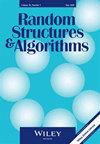随机平衡布尔表达式的可满足阈值是什么?
IF 0.8
3区 数学
Q4 COMPUTER SCIENCE, SOFTWARE ENGINEERING
引用次数: 0
摘要
我们考虑了基于2N个$$ {2}^N $$叶的平衡二叉树的随机布尔表达式模型,该模型随机归属于kN $$ {k}_N $$布尔变量之一或其负值。我们证明了如果对于每一个c>0 $$ c>0 $$它都满足kNexp(−cN)→0 $$ {k}_N\exp \left(-c\sqrt{N}\right)\to 0 $$,那么布尔表达式在高概率下渐近地要么是重言式,要么是反重言式。我们的方法是基于对有限集I在{0,1}i $$ {\left\{0,1\right\}}^I $$上的概率测度集的某种二进制运算的研究。本文章由计算机程序翻译,如有差异,请以英文原文为准。
What is the satisfiability threshold of random balanced Boolean expressions?
We consider the model of random Boolean expressions based on balanced binary trees with 2N$$ {2}^N $$ leaves, to which are randomly attributed one of kN$$ {k}_N $$ Boolean variables or their negations. We prove that if for every c>0$$ c>0 $$ it holds that kNexp(−cN)→0$$ {k}_N\exp \left(-c\sqrt{N}\right)\to 0 $$ then asymptotically with high probability the Boolean expression is either a tautology or an antitautology. Our methods are based on the study of a certain binary operation on the set of probability measures on {0,1}I$$ {\left\{0,1\right\}}^I $$ for a finite set I.
求助全文
通过发布文献求助,成功后即可免费获取论文全文。
去求助
来源期刊

Random Structures & Algorithms
数学-计算机:软件工程
CiteScore
2.50
自引率
10.00%
发文量
56
审稿时长
>12 weeks
期刊介绍:
It is the aim of this journal to meet two main objectives: to cover the latest research on discrete random structures, and to present applications of such research to problems in combinatorics and computer science. The goal is to provide a natural home for a significant body of current research, and a useful forum for ideas on future studies in randomness.
Results concerning random graphs, hypergraphs, matroids, trees, mappings, permutations, matrices, sets and orders, as well as stochastic graph processes and networks are presented with particular emphasis on the use of probabilistic methods in combinatorics as developed by Paul Erdõs. The journal focuses on probabilistic algorithms, average case analysis of deterministic algorithms, and applications of probabilistic methods to cryptography, data structures, searching and sorting. The journal also devotes space to such areas of probability theory as percolation, random walks and combinatorial aspects of probability.
 求助内容:
求助内容: 应助结果提醒方式:
应助结果提醒方式:


